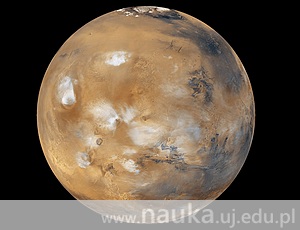
In late September 2015, NASA declared that water may periodically appear on the surface of Mars. Dr Maciej Kania from the JU Institute of Geological Sciences sheds some light on this fascinating discovery.
1Question is a series of articles by the University Marketing science promotion unit, in which specialists and experts from various fields briefly discuss interesting issues related to the world, civilisation, culture, biology, history, and many more.
Without water, there is no life. It should come as no surprise, then, that it is the most sought-after substance in space. The presence of water on other astronomical objects would not only facilitate the potential future colonisation of space, but also give us hope to one day discover extraterrestrial life. If it ever happens, it would be the greatest scientific breakthrough in the history of mankind. Currently, researchers are almost certain that beneath the surfaces of moons orbiting gas giants – Enceladus, Europa, and Ganymede – there are likely oceans. But no matter how amazing these findings may be, they pale in comparison to discovering water on Mars. It has been known for a long time that there are ice caps on the Red Planet, but it is not the same as liquid water – hence the significance of the information.
The discovery was made by a team lead by Lujendro Ojha, a PhD student from the Georgia University of Technology, while researching structures known as RSL (recurring slope lineae). What are they? "They are slim (0.5–5 metres) linear zones, visibly darker than their surroundings (up to 40%), which appear periodically on 33–38 degree declivities," explained Dr Maciej Kania, astrogeology enthusiast specialising in tectonics and structural geology. During the Małopolska Researchers' Night, Dr Kania delivered a lecture on the geology of Mars, Venus and the Moon.
We know more, but...
The first proof of possible liquid water on Mars came with the data delivered by the Mars Global Surveyor. The photographs sent by the spacecraft contained images of contemporary-looking ravines and mudlike sediment. It was only after the Mars Reconnaissance Orbiter (MRO) mission that it became possible to study them in detail. In 2006, the term "RSL" surfaced in the scientific world, which sparked a debate on the origin of these structures. One of the first (and most exciting) hypotheses was that they came into being during the Martian summer, when the ground temperature is sufficiently high to allow liquid water to appear. Since then, many other theories have been formulated.
Lujendra Ojhy's theory, however, has provided more proof that liquid water may have been responsible for the RSL – but it must have been salt water, since even in summer it is too cold for fresh water to become liquid. "The scientists have even conducted an experiment in which they have saturated basalt with salt water (simulating the Martian soil) in order to see how it would present itself on spectroscopic images. Nevertheless, there is no direct, tangible proof that there is liquid water on Mars," Dr Kania said.
To confirm the existence of liquid water on Mars, a rover could be sent to the RSL regions. However, the areas have been designated as special protection areas to ensure they are not contaminated with organisms from Earth. According to the geologist, there is some possibility that some Martian extremophiles inhabit the periodically-wet sands of RSL, but the scientists are more focused on searching for traces of life from approximately 4 million years ago, when Mars was covered with a giant ocean.
In summary, the existence of water on Mars becomes more likely with every proof, but we cannot be absolutely sure of it yet.
Original text: www.nauka.uj.edu.pl





